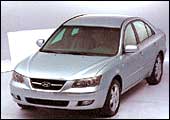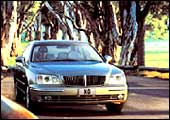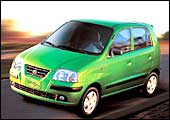 |
| Hyundai Motor India President B.V.R. Subbu
(left) and CEO Steve Yang: Dogged by bad luck last year,
they are planning a strong comeback |
In
B.V.R. Subbu's office at Hyundai Motor India's plant near Chennai,
hangs a Business Today CEO Toon from four years ago. In the toon,
which shows Hyundai reaching the 200,000 car mark, the 49-year-old
President of the Korean car maker looks happy and young. His cropped
hair, like his moustache, is thick, even if greying. So, on a
recent April morning, it's shocking to see that Subbu's hair is
all but gone and what's left of it has turned several shades whiter.
"Well, selling 700,000 cars has done this to me," says
Subbu with his trademark wit still intact.
Hyundai Motor has been in India for about
six years now, but it's not the first five that have depleted
Subbu's top. Rather, it's the last one year. In a passenger car
market that grew almost 18 per cent in 2004-05 to 819,918 units,
Hyundai managed less than 10 per cent. Market leader Maruti Udyog,
in contrast, grew 17 per cent, racking up sales of 417,179 cars.
Tata Motors did better, pushing sales 34 per cent at 144,827 units.
Worse, Hyundai lost market share in all its segments, including
the compact, where it has the Santro and Getz, mid-size (Accent),
and premium (Sonata). For a company that not too long ago led
the market in almost all the segments it was present in, it's
a huge setback. What's going wrong at Hyundai?
The answer, says Subbu, is simple. It was
due to an expansion plan gone awry. Here's what happened. In 2003,
Hyundai announced plans of increasing capacity from 150,000 units
to 250,000 units a year. A key part of this plan involved robotising
the bodyshop. But when the robots were installed, production was
thrown out of gear. Because of bugs in the system, the robots
would break down eight to 10 times a day between April and May
last year. Given that Hyundai was making more than 10,000 cars
a month, it meant a production loss of 20,000 cars. Quips Subbu:
"We had the most awful luck last year."
With fewer cars to sell, Hyundai says, it
had to return deposits for more than 16,500 cars. The company's
top dealer in Delhi, Samara Hyundai, alone turned hundreds of
customers away. "People don't want to wait for a car any
more, and if we can't give them a car within a couple of weeks,
they take their business elsewhere," laments Rajnish Wadhwan,
Samara's owner.
New Launches
Hyundai plans to spice up its portfolio
with new offerings. |
 New
Sonata New
Sonata
The new Sonata looks similar to the current generation of
Audi vehicles, while the older version borrowed from Ford's
Jaguar. Hyundai hopes that a spiffy Sonata will help regain
the ground it lost to the new Honda Accord.
Launch: June-July 2005
 New
Accent New
Accent
Showcased at the recent New York Auto Show, the next-generation
Accent is still at least 18 months from production. However,
an updated Accent will be crucial for Hyundai to regain
crucial lost market share in the booming 'C' segment.
Launch: End-2006
 XG XG
One of Hyundai's top-line vehicles, this car, if launched
in India, would take on the likes of the Mercedes E-Class
and the Skoda Superb. The question is, does Hyundai have
the brand appeal to woo finicky buyers in this segment?
Launch: Maybe 2006
 New
Santro New
Santro
The Santro is almost a decade old, and despite going through
several iterations (ZipDrive, ZipPlus and Xing), a generational
change might be needed to keep the car fresh among buyers.
After all, three-fourths of its sales come from Santro.
Launch: 2008 (tentative)
|
Losing Touch?
The comment is telling. With rejuvenated
competitors like Maruti flooding the market, Hyundai seems to
have lost some amount of customer pull. Customers are willing
to wait, but only for the cars they think offer greater perceived
value. For instance, Honda City is said to have a waiting period
of six weeks, and Maruti Alto ran a delivery lag of three to four
weeks last festive season when it dropped the small car's price
to Rs 2.30 lakh. Subbu, however, blames last year's production
snafus for the loss in sales. Besides, Hyundai chose to keep up
exports at the cost of domestic sales.
It's hard to deny that the loss was real.
Yet, it's evident too that the Korean warrior may be losing its
edge. Take its two recent launches. The Getz, launched seven months
ago to compete in the compact segment along with the Santro, has
sold less than 10,000 units. The other new car, the Elantra, has
sold less than 5,000 since its introduction in April 2004. (Tucson,
an SUV, has just been launched). Hyundai is not a company known
to sit back and relax, especially when it comes to new launches.
So why didn't it push its marketing into overdrive?
Production loss apart ("what's the point
if you don't have enough cars to sell?" asks Subbu), there
were other reasons. If competitors are to be believed, the Getz,
priced between Rs 4.5 lakh and Rs 4.75 lakh (ex-showroom, Delhi)
offers Hyundai the lowest profit margins of all its cars. Therefore,
the company seems to have gone slow on the hatchback. As for Elantra,
even Subbu admits that Hyundai may have got its positioning wrong.
"I don't think we managed to convey the value proposition
that the car offers," says Subbu. As a result, price-conscious
buyers opted for the Chevrolet Optra, and brand-conscious customers
snapped up the Toyota Corolla and Skoda Octavia.
The premium segment was another niche where
Hyundai led with its Sonata between its launch in 2001 and 2003,
when Honda rolled out its new Accord. Since then, the Accord (and
to an extent, Toyota's Camry) has outsold Sonata by a wide margin
every year. In 2003-04, the Accord sold 2,081 units compared to
Sonata's 1,224, and last year it grew 45 per cent at 3,009. In
contrast, Sonata's sales fell to 873. Reason? Sonata's dated looks.
No wonder, then, Hyundai is planning to launch an all-new Sonata
that abandons the lines borrowed from Ford's Jaguar in favour
of Audi A6's sharper looks.
 |
| Hyundai's robotic assembly line in Chennai:
Moody robots wreaked havoc last year, resulting in production
losses |
But what should have Hyundai really worried
is the competition in the compact segment, where the Santro accounts
for 84 per cent of Hyundai's unit sales and around three quarters
of the Rs 7,500 crore revenues last year. The "tall boy",
despite three makeovers, has lost considerable ground to an emboldened
Maruti, which has not one but three cars in this space: the Alto,
which sells one out of every four in the segment, the WagonR and
the Zen. Together, the three account for 55 per cent of compact
sales. Tata Motors' small car, Indica, also has a 21 per cent
share, not too far behind Hyundai's 23 per cent.
Worryingly for Hyundai, Maruti's compact portfolio
is about to get stronger. In May, the market leader is expected
to unveil Swift, a new compact launched primarily for the European
market. Worse, Maruti watchers reckon that it could be priced
at around Rs 3.90 lakh, which means WagonR will have to slash
its sticker price (its top-end Vxi is priced at Rs 3.87 lakh in
Delhi) to allow differentiation. Hyundai's poor pre-emption strategy
so far has been to take out controversial ads touting Santro as
a five-seater (the point being, WagonR is a four-seater). Says
a Mumbai-based analyst: "If Hyundai alters pricing of its
current products to match market realities, I am sure they can
pick themselves up."
Hyundai's India boss Steve Yang-the third
CEO in three years-doesn't doubt a comeback. "We are serious
about the Indian market, and although last year's incidents were
unfortunate, we will come back strong this year," says Yang.
Serious Hyundai is. It recently announced plans of investing $500
million (Rs 2,200 crore) in a second plant that will up capacity
to 400,000 units a year. India is already an export hub for the
Santro, but Yang plans to add Getz to the list. That means a higher
local content and, in turn, cheaper Getz. In addition, there are
other cars in the pipeline (See New Launches).
Early this year, when Hyundai did its annual
puja, the top brass prayed harder than usual for better luck ahead.
Whether or not the God above will answer their prayers is anybody's
guess. But knowing Hyundai, it will probably come back charging
into the market. Even if that means Subbu going bald.
|





 New
Sonata
New
Sonata New
Accent
New
Accent XG
XG New
Santro
New
Santro